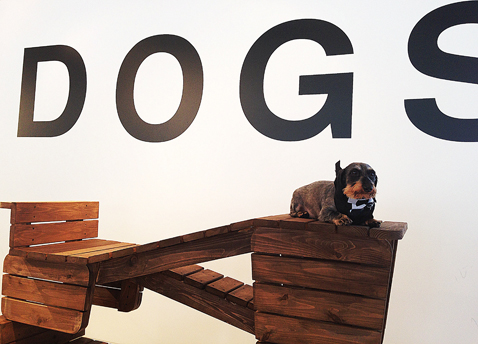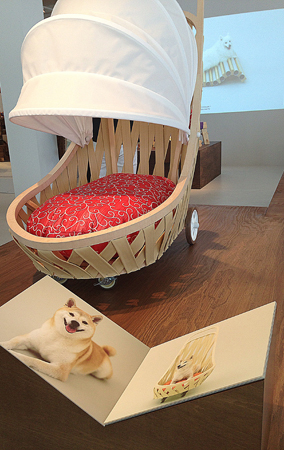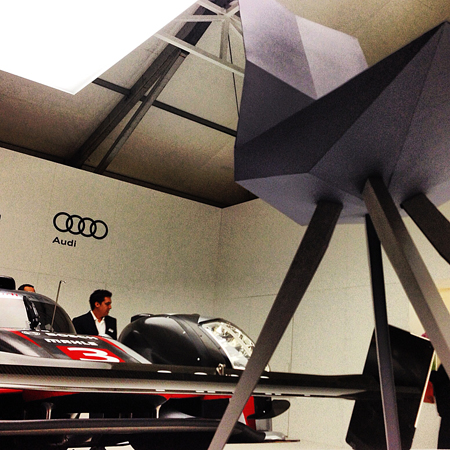Art Basel Week: From Dog Furniture to Audi Chairs
ABC News' Seni Tienabeso reports from Miami:
Its 10:55 a.m. in South Beach, and the world's well-heeled and well-to-do wait in line, pressed against one another. But they are not waiting to get into the hot new club. It's not even night-time.
Within minutes the doors will open, allowing VIPs entry to preview the signature event of Art Week, seven days filled with glitz, glamour, debauchery and art so uniquely Miami that to outsiders it might all seem like a joke. But it's far from a joke. This is the most important art fair in the Americas, and by the time it's over, tens of millions of dollars will have changed hands.
Art in 2012 at Basel can be a canvas, a chair or a hotel.
After scouring the city and its 2,000-plus temporary galleries and art installations, these are the quirkiest displays around:
"Architecture for Dogs": Less than 10 minutes away from Art Basel in the Design District, a formerly dilapidated neighborhood that has been transformed into a tropical Soho, dogs can lounge on furniture built for them while their owners watch. It's called " Architecture for Dogs," and it's an early hit.

Kenya Hara, "Architecture for Dogs." (Seniboye Tienabeso/ABC News)
Thirteen pieces ranging from a "Doghouse that Walks" to objects that let dogs lie in the shade is a "gift to man's best friend," according to Kenya Hara, a renowned Japanese designer who created the posh do-it-yourself installations. The gallery is allowing the public, during select times, to bring its dogs and have them play with the art. Hara hopes people go on architecturefordogs.com, replicate the designs at home and take photos of the pieces for a book the gallery plans to release after its installation concludes a global tour - from Miami to Tokyo - next year.

Kenya Hara, "Architecture for Dogs." (Seniboye Tienabeso/ABC News)
"Black Lords": Back in the heart of South Beach's famous Collins Avenue, Desi Santiago took architecture and dogs to an entirely different level, somehow convincing the Lords South Beach hotel to allow him to paint the entire historical building black while placing large balloons resembling a God-zilla size dog on its roof. The "Black Lords" installation, commissioned by Perrier, is best seen in its totality from across the street, poolside at the Dream Hotel, where those with nothing to do but hang out sip on cocktails and bake themselves in the Miami winter sun.

Desi Santiago, "Black Lords." (Seniboye Tienabeso/ABC News)
In the hotel, Santiago, the New York Times anointed "artist of the moment," famed for mixing fashion and art, asks before he heads off for tea with Stella McCartney, "Do you want your future read?"
In the middle of the hotel's open outdoor space lies a box where you put in a card with a wish, press your fingers inside an opening on top and wait for your future to be read as the menacing dog-like face at the top of the hotel, seemingly peering at onlookers below in what looks like approval and disapproval, begins to smoke …
Santiago calls this interactive work, which envelops the entire hotel and took eight days to build, a "vision for the future." His fascination with fortune-telling dates back to college, where he tried to perfect mind-reading experiments, some of which he believes proved effective. The black symbolizes the deaths in his family. All of it is interactive. He says "Black Lords" is its official name, but he calls the dog Gypsy, after his actual dog. It glimmers at night, especially when the exclusive and invite-only Basel party crowd stops by to play.

Desi Santiago, "Black Lords." (Seniboye Tienabeso/ABC News)
"R18?: In the Design Miami tent, the world's most important and influential design exhibition, furniture is taken to untold heights. Audi, known for car seats, took on chairs. It commissioned a team that looked at its ultra-lightweight carbon fiber " R18? car as the inspiration behind its "77g" chair. The chair, which took 11 months to design, stands out amid the celebs, commoners and jaw-dropping furniture that fill the tents.

Audi's "77G." (Seniboye Tienabeso/ABC News)
"Design has order to push technological and aesthetic values and lead where we all go," said Reed Kram of Kram/Weisshaar, which designed the project. "These types of designs could be central pieces in our lives in the future. They are light, cheaper to ship as a result and more environmentally-friendly when you do."
"History Line": Nick Gentry at the Scopes art show in Midtown Miami had his own approach to conservation, taking floppy discs - remember those 3.5-inch marvels of technology that are now as useful as a typewriter - into a work of art. The work is simple, yet intricate and costs $17,000 - a steal compared to some of the other pieces of art on display.

Nick Gentry, "History Line." (Seniboye Tienabeso/ABC News)
The Scopes fair is known to house the artist of tomorrow, but this piece stopped casual onlookers in their tracks. Many of the artists at Scopes eventually end up in the more famous and exclusive Art Basel, where it's hard to take a step without wondering "what is that" and "wow": two thoughts at the heart of modern day art during every era.

Nick Gentry, "History Line." (Seniboye Tienabeso/ABC News)